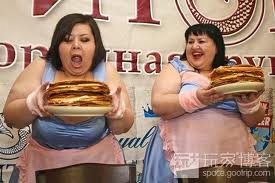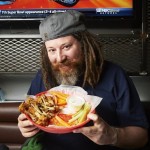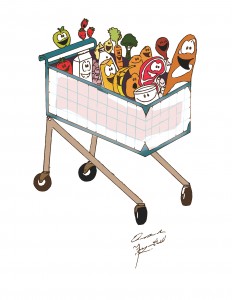Sports
Competitive eating: Ready, set, gorge!
Friday, Jun 06, 2014 9:59 am
Major League Eating applies some of the same principles as Major League Baseball: Play fair, keep your cool under pressure and don’t be a slacker in the off-season. Got what it takes? Let’s eat!
By Roz Cummins
 It seemed like a good idea at the time. Cape Cod resident Matt Schultz saw a small item in the local paper – an ad announcing an essay contest for people who wanted to enter a peel’n’eat shrimp contest sponsored by Old Bay Seasoning, the much-loved, all-purpose seafood spice. Matt, a wine distributor by trade, recalls, “I love shrimp. I love Old Bay. This was tailor-made for me. I had nothing scheduled that morning, so I wrote an essay.â€
It seemed like a good idea at the time. Cape Cod resident Matt Schultz saw a small item in the local paper – an ad announcing an essay contest for people who wanted to enter a peel’n’eat shrimp contest sponsored by Old Bay Seasoning, the much-loved, all-purpose seafood spice. Matt, a wine distributor by trade, recalls, “I love shrimp. I love Old Bay. This was tailor-made for me. I had nothing scheduled that morning, so I wrote an essay.â€
To his surprise, he was one of the 12 essay contest winners who went on to compete in Old Bay’s New England regional shrimp eating contest in Charlestown, Rhode Island. After a two-minute peel’n’eat gorge, Matt found himself in the top three. A few months later, he was sent on to the national competition in Baltimore, a five-minute contest that proved much more challenging. As he puts it, “I’m good at peeling but not as good at eating.â€
Matt lost in Baltimore that sunny July afternoon and spent the rest of the day recovering in his darkened hotel room, his stomach churning in distress over 50 of those pesky prawns. Not surprising. Competitive eating takes preparation. Matt had none, and was in fact bested in Baltimore by a professional competitive eater.
In fact, many people make their livings at this “sport.†For some, the profession is even quite lucrative.
Putting money where your mouth is
Formed to champion those in the profession, Major League Eating (MLE), a division of International Federation of Competitive Eating , has roughly 350 active members and ranks the top 50 professionals. The league presents more than 80 sanctioned events each year and all but a few are held in the United States.
Pro gurgitators can make a decent living, with some making paid appearances at various events, and an elite few racking up the dollars in ads for the likes of Mastercard and KFC. Purses for different contests vary: Nathan’s Famous hot dog competition pays the male and female winners $20,000. Too Jays in Florida and the Hooters Wing Eating competitions also award large sums. Many contests award roughly $2,500 to the winners, although some events have smaller prizes ranging from trophies to simple bragging rights.
Competitive eater Crazy Legs Conti is one of the world’s most popular and well-known. His enthusiastic gustatory endeavors were showcased in the 2004 documentary Crazy Legs Conti: Zen and the Art of Competitive Eating.A native of Belmont, Mass., he grew up eating healthy food and says he was always “a good eater.â€
Conti got his start as a pro in 2002 when he traveled to New Orleans to see the Patriots play in Superbowl XXXVI. Once there, he couldn’t get a ticket so he stopped in at Felix’s, a local bar, to get some oysters and watch the game remotely. There he saw a man who bore an eerie resemblance to the Roman god Neptune downing plate after plate of the bivalves.
A Felix staff member noticed Crazy Legs’ interest and told him that across the street at Acme Seafood, the current record for eating oysters was 33 dozen. If Crazy Legs could best that by another dozen, the oysters would be free.
Crazy Legs crossed the street and downed 34 dozen oysters in in a matter of minutes. Word of his record-breaking achievement got back to IFOCE headquarters, and soon Crazy Legs was a fixture at the organization’s many events. He has won many more contests since, and currently holds two MLE records, one for buffet (5 ½ pounds in 12 minutes) and the other for French-cut green beans (2.71 pounds in six minutes).
Belly up to the burritos
If gulping green beans doesn’t appeal, avid gurgitators have a wide-ranging menu of other foods to choose from, including (but not limited to) lobster, cannoli, chicken wings, BBQ ribs, guacamole, burritos, butter, cabbage, catfish, cherrystones, baked beans, birthday cake, chili cheese fries, deep-fried okra, cupcakes, asparagus, cranberry sauce and calamari.
Over the years, Conti’s discovered that the type of food he eats doesn’t matter as much as the technique. Hot dog contests? Separate the bun from the beef. Oysters? It’s all a matter of how you slurp. And always remember: pace yourself. If it’s as much as you can eat in 10 minutes, don’t rush through the bulk of your plate in half that time—you’ll never make it to the finish line.
“It’s not a sprint, it’s a marathon,†Conti’s fond of saying. He should know. At this point, he appears in 25 to 40 contests per year. That’s a lot to swallow.
Don’t try this at home
As Matt Schultz learned in his trial by, um, shrimp, competitive eating is no place for amateurs. In fact, some people take a dim view of competitive eating. Accounts of health consequences have been linked to the contests, although cause and effect aren’t proven.
Consider, for example, the death of Edward Archbold from “asphyxia due to choking and aspiration of gastric contents,” after downing dozens of roaches in an effort to win a python in a pet-store contest. Mort Hurst had a stroke after eating38 soft-boiled eggs in 29 seconds. Fortunately he recovered and went on to compete again.
Long-time competitive eater Takeru Kobayahsi developed an arthritic jaw after years of champion chewing on meatballs, Twinkies, hamburgers, pizza and pasta. And Conti certainly courted the hereafter when he lowered himself into a life-size “popcorn sarcophagus†and ate his way out—a breathless stunt, to be sure. [insert video]
Because of such dangers, the IFOCE counsels against speed-eating in home environments and adheres to strict safety rules at their events. It only allows those over 18 to compete and requires EMTs at all of their contests and publicity events demos, no matter how brief. Despite the perils, the feeding frenzy is likely to last, givien the crowds these competitions draw, as you can see from this video of a recent Nathan’s contest, a rite of summer that many fans travel many miles to witness.
Fat or fit?
Of all the potential health hazards of oversized eating, obesity is not necessarily one of them. The diminutive Sonya Thomas, one of just a handful of female competitive eaters—and feared by many of her male counterparts—weighs a mere 105 pounds. The stiff-jawed Kobayahsi (aka the Tsunami) stands 5’8’’ and weighs 128 pounds, despite the fact that he holds the record for eating 50 Nathan’s Coney Island hotdogs in 12 minutes.
Conti is no exception. When he’s not competing, he keeps the scales steady with a healthy diet and regular workouts. At home (he now lives in New York), he eats a lot of quinoa and whole grain bread and does his best to adapt to his girlfriend’s vegetarian diet.
In the end, competitive eating has been good to Conti, although he’s never pursued it full-time. When he’s not competing, Conti works various gigs for cash—as a window washer, nude model and sperm donor—as well as a high-end mixologist in New York City. Customers recognize him. “My stomach is more famous than the rest of me,†he notes wryly.
How many people can say that?
Roz Cummins is NPP’s food editor. She has worked in every possible permutation of food co-op, natural foods store, and granola-type restaurant. She is currently at work on a book about tea and pastries. Roz can be reached at rozaroni@gmail.com.






Leave a Reply